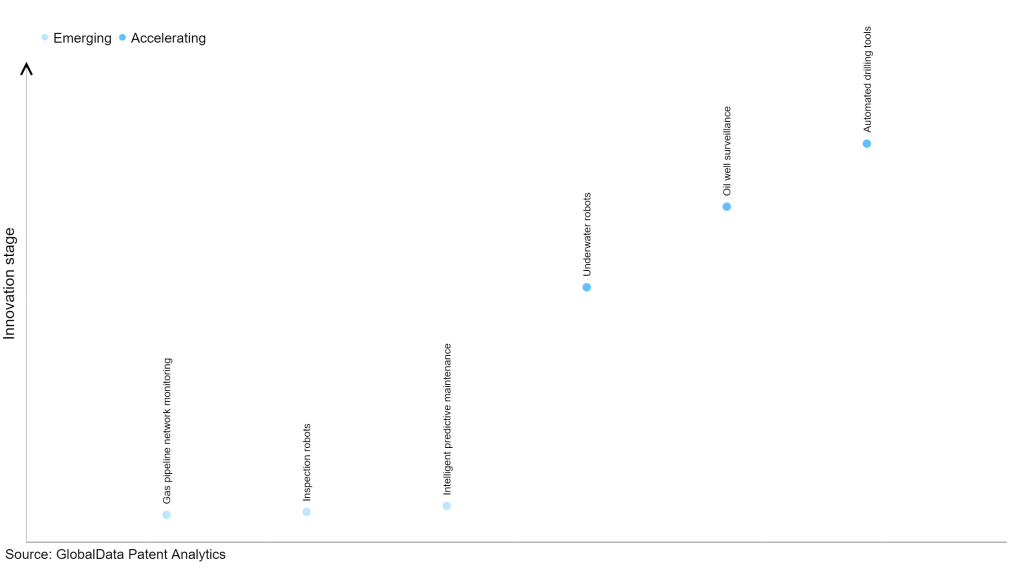The oil and gas industry continues to be a hotbed of patent innovation. Activity is driven by an increased need for reducing capital and operating expenses, enhancing workforce safety, reducing the carbon footprint, and optimising production. Digital technologies are enabling the oil and gas industry in achieving these objectives. This is characterised by the growing importance of technologies such as artificial intelligence (AI), internet of things (IoT), and robotics in day-to-day tasks. In the last three years alone, there have been over 327,000 patents filed and granted in the oil and gas industry, according to GlobalData’s report on Internet of Things in oil & gas: automated drilling tools. Buy the report here.
However, not all innovations are equal and nor do they follow a constant upward trend. Instead, their evolution takes the form of an S-shaped curve that reflects their typical lifecycle from early emergence to accelerating adoption, before finally stabilizing and reaching maturity.
Identifying where a particular innovation is on this journey, especially those that are in the emerging and accelerating stages, is essential for understanding their current level of adoption and the likely future trajectory and impact they will have.
65+ innovations will shape the oil & gas industry
According to GlobalData’s Technology Foresights, which plots the S-curve for the oil & gas industry using innovation intensity models built on over 201,000 patents, there are 65+ innovation areas that will shape the future of the industry.
Within the emerging innovation stage, gas pipeline network monitoring, inspection robots, and intelligent predictive maintenance are disruptive technologies that are in the early stages of application and should be tracked closely. Underwater robots, oil well surveillance, and automated drilling tools are some of the accelerating innovation areas, where adoption has been steadily increasing.
Innovation S-curve for Internet of Things in the oil & gas industry

Automated drilling tools is a key innovation area in Internet of Things
Automated drilling tools are control systems used for carrying out various drilling activities automatically right from well planning and design to downhole tasks. These tools limit human intervention throughout the drilling process, thereby making it safer and efficient. IoT-enabled sensors aid in monitoring drilling performance in real-time, capturing vibrational statistical data, condition of the drill bit, downhole temperatures, and rock characteristics, among others. They also help in enhancing operational efficiency and reducing the overall drilling costs.
GlobalData’s analysis also uncovers the companies at the forefront of each innovation area and assesses the potential reach and impact of their patenting activity across different applications and geographies. According to GlobalData, there are 100+ companies, spanning technology vendors, established oil & gas companies, and up-and-coming start-ups engaged in the development and application of automated drilling tools.
Key players in automated drilling tools – a disruptive innovation in the oil & gas industry
‘Application diversity’ measures the number of applications identified for each patent. It broadly splits companies into either ‘niche’ or ‘diversified’ innovators.
‘Geographic reach’ refers to the number of countries each patent is registered in. It reflects the breadth of geographic application intended, ranging from ‘global’ to ‘local’.
Patent volumes related to automated drilling tools
Source: GlobalData Patent Analytics
Halliburton, Schlumberger, and Baker Hughes are the leading companies in automated drilling tools based on their recent patent filings. Other top contributors include Helmerich & Payne, Shell, and Weatherford International.
Halliburton’s automated drilling tools incorporate advanced electronics and sensor technologies with revolutionary algorithms. These aid in obtaining telemetry data to reduce reservoir ambiguity and better identify prospects for drilling, thereby enhancing the accuracy and reliability of drilling operations.
Schlumberger’s automated drilling systems enable operators to control all major functions from a single source and thus enhance the staff coordination, efficiency, and consistency of drilling wells.
Baker Hughes' i-TrakTM drilling automation services lower operational risks and costs associated with well drilling.
Weatherford’s automated pressure drilling system increases safety, efficiency, and productivity of drilling operations.
In terms of application diversity, Halliburton leads the pack, while Schlumberger and Baker Hughes stood in the second and third positions, respectively. By means of geographic reach, Weatherford International held the top position, followed by Merlin Technology and Rio Tinto.
To further understand the key themes and technologies disrupting the oil & gas industry, access GlobalData’s latest thematic research report on Internet of Things in Oil & Gas.
Data Insights
From

The gold standard of business intelligence.
Blending expert knowledge with cutting-edge technology, GlobalData’s unrivalled proprietary data will enable you to decode what’s happening in your market. You can make better informed decisions and gain a future-proof advantage over your competitors.



